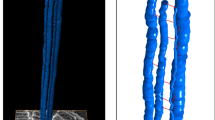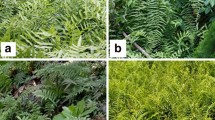Abstract
In the developing xylem bundles of young stems, the presence of immature living vessel elements can strongly restrict or even block axial hydraulic conductance, especially in newly matured vessels. Lateral connections between vessels may provide an alternative pathway for water movement to bypass these closed, living elements. Using the grapevine as a model system, the present study aimed to demonstrate the effects of living vessel elements on water movement patterns, and the importance of lateral flow for effective water conductivity in the developing bundles. Living vessel elements were detected using dye staining and the pattern of vessel development and maturation was then monitored. The importance of lateral flow was confirmed using several approaches: (1) capacity for lateral flow, (2) effect of increasing the distance of water transport, and (3) effect of ion concentrations. Living vessel elements were found along the developing bundles, they occupied a significant proportion of the distal and peripheral parts of the flow path, forming a substantial barrier to apoplastic water flow. Water in the developing xylem bundles could move easily from vessel to vessel and between secondary and primary xylem. Furthermore, data from increasing the transport length and altering the ion concentrations supported the critical contribution of the lateral flow to the total hydraulic conductance within the developing bundles. The hydraulic architecture of the developing xylem bundles is described. The results are discussed in terms of reliability and efficiency of water transport during shoot growth and development.






Similar content being viewed by others
References
Bull TA, Gayler KR, Glasziou KT (1972) Lateral movement of water and sugar across xylem in sugarcane stalks. Plant Physiol 49:1007–1011
Burggraaf PD (1972) Some observations on the course of the vessels in the wood of Fraxinus excelsior L. Acta Bot Neer 21:32–47
Chatelet DS, Matthews MA, Rost TL (2006) Xylem structure and connectivity in grapevine (Vitis vinifera) shoots provides a passive mechanism for the spread of bacteria in grape plants. Ann Bot 98:483–494
Chaves T, Regalado AP, Chen M, Ricardo CP, Showalter AM (2002) Programmed cell death induced by (β-d-galactosyl)3 Yariv reagent in Nicotiana tabacum BY-2 suspension-cultured cells. Physiol Plant 116:548–553
Comstock JP, Sperry JS (2000) Theoretical considerations for optimal conduit length for water transport in vascular plants. New Phytol 148:195–218
Cronshaw J, Bouck GB (1965) The fine structure of differentiating xylem elements. J Cell Biol 24:415–431
Ellmore GS, Zanne AE, Orians CM (2006) Comparative sectoriality in temperate hardwoods: hydraulics and xylem anatomy. Bot J Linn Soc 150:61–71
Ewers FW, Fisher JB, Chiu ST (1990) A survey of vessel dimensions in stems of tropical lianas and other growth forms. Oecologia 84:544–552
Frensch J, Steudle E (1989) Axial and radial hydraulic resistance to roots of maize (Zea mays L.). Plant Physiol 91:719–726
Fujii T, Lee SJ, Kuroda N, Suzuki Y (2001) Conductive function of intervessel pits through a growth ring boundary of Machilus thunbergii. IAWA J 22:1–14
Hacke UG, Sperry JS, Wheeler JK, Castro L (2006) Scaling of angiosperm xylem structure with safety and efficiency. Tree Physiol 26:619–701
Kitin P, Sano Y, Funada R (2001) Analysis of cambium and differentiating vessel elements in kalopanax pictus using resin cast replicas. IAWA J 22:15–28
Kitin PB, Fujii T, Abe H, Funada R (2004) Anatomy of the vessel network within and between tree rings of Fraxinus lanuginosa (Oleaceae). Am J Bot 91:779–788
Kitin P, Fujii T, Abe H, Takata K (2009) Anatomical features that facilitate radial flow across growth rings and from xylem to cambium in Cryptomeria japonica. Ann Bot 103:1145–1157
Marshall C (1996) Sectoriality and physiological organization in herbaceous plants: an overview. Vegetation 127:9–16
McCulley M (1995) How do real roots work? Plant Physiol 109:1–6
Meuser J, Frensch J (1998) Hydraulic properties of living late metaxylem and interactions between transpiration and xylem pressure in maize. J Exp Bot 49:69–77
Milburn JA (1996) Sap ascent in vascular plants: challengers to the Cohesion theory ignore the significance of immature xylem and the recycling of Munch water. Ann Bot 78:399–407
Orians CM, Jones CG (2001) Plants as resource mosaics: a functional model for predicting patterns of within-plant resource heterogeneity to consumers based on vascular architecture and local environmental variability. Oikos 94:493–504
Orians CM, van Vuuren MM, Harris NL, Babst BA, Ellmore GS (2004) Differential sectoriality in long distance transport in temperate tree species, evidence from dye flow, 15 N transport, and vessel element pitting. Trees 18:501–509
Orians CM, Smith SDP, Sack L (2005) How are leaves plumbed inside a branch? Differences in leaf-to-leaf hydraulic sectoriality among six temperate tree species. J Exp Bot 56:2267–2273
Salleo S, LoGullo MA, Oliveri F (1985) Hydraulic parameters measured in 1-year-old twigs of some Mediterranean species with diffuse-porous wood. J Exp Bot 36:1–11
Schubert A, Lovisolo C, Peterlunger E (1999) Shoot orientation effects vessel size, shoot hydraulic conductivity and shoot growth rate in Vitis vinifera L. Plant Cell Environ 22:197–204
Shane MW, McCully ME, Canny MJ (2000) Architecture of branch root junctions in maize: structure of the connecting xylem and the porosity of pit membranes. Ann Bot 85:613–624
Sperry JS, Hacke UG, Wheeler JK (2005) Comparative analysis of end wall resistivity in xylem conduits. Plant Cell Environ 28:456–465
St Aubin G, Canny MJ, McCully ME (1986) Living vessel elements in the late metaxylem of sheathed maize roots. Ann Bot 58:577–588
Stevenson JF, Matthews MA, Greve LC, Labavitch JM, Rost TL (2004) Grapevine susceptibility to Pierce’s disease. I. Relevance of hydraulic architecture. Am J Enol Vitic 55:228–237
Sun Q, Rost TL, Matthews MA (2006) Pruning-induced tylose development stem of current-year shoots of Vitis vinifera (Vitaceae). Am J Bot 93:1567–1576
Taneda H, Tateno M (2007) Effects of transverse movement of water in xylem on patterns of water transport within current-year shoots of kudzu vine, Pueraria lobata. Funct Ecol 21:226–234
Thorne ET, Young BM, Young GM, Stevenson JF, Labavitch JM, Matthews MA (2006) The structure of xylem vessels in grapevine and a possible passive mechanism for the systemic spread of bacterial disease. Am J Bot 93:497–504
Tyree MT, Ewers FW (1991) The hydraulic architecture of trees and other woody plants. New Phytol 119:345–360
Tyree MT, Davis SD, Cochard H (1994) Biophysical perspective of xylem evolution: is there a tradeoff of hydraulic efficiency for vulnerability to disfunction? IAWA J 15:335–360
Tyree MT, Zimmermann MH (2002) Xylem structure and the ascent of sap, 2nd edn. Springer, Berlin
Van Ieperen W, Van Meeteren U, Van Gelder H (2000) Fluid ionic composition influences hydraulic conductance of xylem conduits. J Exp Bot 51:769–776
Vuorisalo T, Hutchings MJ (1996) On plant sectoriality, or how to combine the benefits of autonomy and integration. Vegetation 127:3–8
Wheeler JK, Sperry JS, Hacke UG, Hoang N (2005) Intervessel pitting and cavitation in woody Rosaceae and other vesselled plants: a basis for a safety versus efficiency trade-off in xylem transport. Plant Cell Environ 28:800–812
Zanne AE, Sweeney K, Sharma M, Orians CM (2006) Patterns and consequences of differential vascular sectoriality in 18 temperate trees and shrub species. Funct Ecol 20:200–206
Zimmermann MH, Jeje AA (1981) Vessel-length distribution in stems of some American woody plants. Can J Bot 59:1882–1892
Zwieniecki MA, Melcher PJ, Holbrook NM (2001a) Hydrogel control of xylem hydraulic resistance in plants. Science 29:1059–1062
Zwieniecki MA, Melcher PJ, Holbrook NM (2001b) Hydraulic properties of individual xylem vessels of Fraxinus americana. J Exp Bot 52:1–8
Zwieniecki MA, Orians CM, Melcher PJ, Holbrook NM (2003) Ionic control of the lateral exchange of water between vascular bundles in tomato. Ann Bot 54:1399–1405
Acknowledgments
We thank Abdelaziz Labidi and Belgacem Hadid for their support and assistance. Special thanks are extended to Drs. Hocine Bensaha, Mohamed Amine Benhadia, Mohamed Hocine Benaissa, Nouredine Slimani and the anonymous referees for helpful comments on earlier versions of this manuscript. We are also grateful to Sofiane Amira, Ali Lahcini, Abdessalem Bougafla and Saci Djouwahi for their technical support.
Author information
Authors and Affiliations
Corresponding author
Additional information
Communicated by S. Mayr.
Rights and permissions
About this article
Cite this article
Halis, Y., Djehichi, S. & Senoussi, M.M. Vessel development and the importance of lateral flow in water transport within developing bundles of current-year shoots of grapevine (Vitis vinifera L.). Trees 26, 705–714 (2012). https://doi.org/10.1007/s00468-011-0637-8
Received:
Revised:
Accepted:
Published:
Issue Date:
DOI: https://doi.org/10.1007/s00468-011-0637-8




